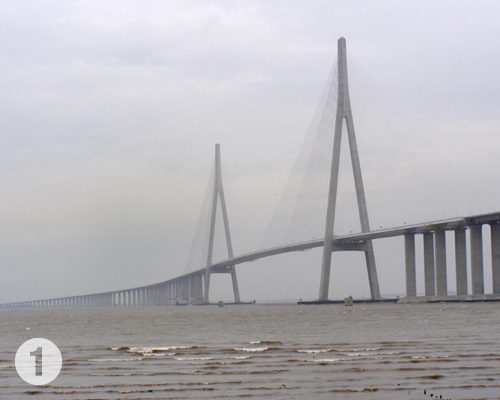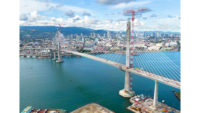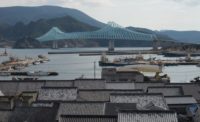The 1,104-meter-long main span of the Russky Island cable-stayed bridge will set a new length record when that Bosporus Strait crossing opens next year. Only two other cable-stayed-bridge main spans have surpassed the 1,000-m mark. But thanks to evolving technologies, materials and advanced methods of measuring external factors, all this could change, say bridge engineers.
For our first global edition of 2012, ENR has compiled a list of the top 10 longest bridges that use cable stays for structural support. Check out the slide show to see the list or continue reading below.
Longer Spans
Traditionally, very long-span bridges tend to go the suspension route, because cable-stayed bridges are limited by the stiffness of their superstructure, says Joe Tse, manager of long-span bridges for Parsons Brinckerhoff, New York City.
“There is a point [at which] the current high-strength cables will exhibit some non-linear behavior. The weight creates a sag in the cable,” Tse says. “Once you get closer to 3,000 meters, typically you go for suspension bridges. But suspension bridges need fairly good ground conditions and fairly massive anchorages. In very poor soil conditions and with cost issues for concrete, then we might look at cable-stayed bridges.”
Advances in various materials may someday enable cable-stayed bridges to surpass 1,100-m-long main-span lengths. These materials include composites and lighter types of steel for the superstructure, says Craig Finley, founder of Finley Engineering Group, Tallahassee, Fla. Evolving software is improving measurements of wind impacts, which also will allow for longer cable-stayed spans, Finley adds.
Further, evolving concrete mixes are enabling longer-span bridges. “Cable forces are part of a closed force system permitting lighter elements as the compression forces are balanced within the deck,” says Jamey Barbas, global director of strategic projects for Hardesty and Hanover, New York City.
“The higher-strength concrete mixes allow designers to take full advantage of the compressive nature of the cable-stay system. Improved concrete mixes also yield benefits for composite designs by [using] steel-box superstructures for longer-span weight reduction.”
Construction methods and equipment also have advanced to meet design demands, Barbas says. “Climbing forms and larger cranes are enabling taller towers and longer spans to be constructed. The forms are reducing costs and provide for the more complex pylon shapes that are required to deal with the some of the large forces more effectively,” Barbas says.
Linda Figg, president and CEO of Figg Engineering Group, Tallahassee, points to the Penobscot Narrows Bridge as an example of new materials being tested: Three of its cables have fiber-reinforced polymer strands (ENR 7/10/06 p. 26).
The bridge, with a 354-m-long main span, also features the firm’s patented cable-cradle system, which allows for cables to be any size. “With bigger cables, longer spans can be achieved, and installation uses lighter equipment and less labor,” Figg says.
The cable-cradle system also allowed for the Veteran’s Glass City Skyway Bridge in Maumee, Ohio, to have enormous cables, with the largest comprising 156 strands, Figg adds.
Wind is another obstacle to very long cable-stayed bridges. A long, slender superstructure coupled with decreasing efficiency in the cables can make a bridge act much like a sail. “The aerodynamics begin to work against you,” says Tse.
Mitigating methods range from fins and fenders to streamlining the bridge's cross section, which makes the towers rounder to deflect wind, to dampers. “A lot of dampers are located on the deck level, but once you get into really long spans, you need to put dampers on the towers also,” notes Tse.
Two Basic Shapes
There are two basic types of cable-stay arrangements: the fan and the harp. The top 10 longest bridges feature modified fan configurations rather than harp configurations because the latter renders the cable stays parallel. That increases compression in the superstructure, says Tse.
“The fan arrangement was used on the early cable-stay bridges, taking the basic design from the existing suspension-bridge methodology,” notes Barbas. “The main cables of a suspension bridge rest over the tower tops in cable saddles. Similarly, the original fan arrangements for cable-stay bridges passed over the pylon tops. This arrangement was adequate for the earlier, moderate-size cable-stay bridges [in which] the diameter and number of stays were small.”
But as main-span lengths increased, the loads increased and the modified fan arrangement developed, Barbas adds. “In the modified fan arrangement, the cable stays are spaced out over the top portion of the pylon so as to have more room to be individually anchored near the pylon top.
The cable stays for the harp arrangement are anchored in equal spaces over much of the height of the pylon,” she says. “It gives a pleasant aesthetic appearance but is not as structurally efficient as the fan arrangements, since the pylon has greater bending moment on it when the loading is not symmetric.”
Adding intermediate piers to the back spans stiffens the tower behavior, improving its ability to deflect wind, Tse says. The Russky Island bridge, which will have a record-breaking 320.9-m-tall tower and one cable stay reaching 580 m long, includes such piers.
“It’s not inconceivable that cable-stayed bridge spans can someday reach 2,000 meters,” says Tse. “I would say the economics of it is going to be the key.”
Top 10 Longest Bridges
Click on the slide show to read more about these record-setting bridges around the globe.
1. SUTONG BRIDGE
Length of main span: 1,088 meters.
Owner: Jiangsu Provincial Communications Dept.
2. STONECUTTERS BRIDGE
Length of main span: 1,018 meters.
Owner: Hong Kong Highways Dept.
3. EDONG BRIDGE
Length of main span: 926 meters.
Owner: Hubei Edong Changjiang Expressway Bridge Co. Ltd.
4. TATARA BRIDGE
Length of main span: 890 meters.
Owner and design firm: Honshu-Shikoku Bridge Authority.
5. PONT DE NORMANDIE
Length of main span: 856 meters.
Owner: Haute-Normandy Regional Council.
6. JINGYUE BRIDGE
Length of main span: 816 meters.
Owner: Hubei Jingyue Changjiang Expressway Bridge Construction Project Headquarters.
7. INCHEON BRIDGE
Length of main span: 800 meters.
Owner: Incheon Bridge Co. Ltd. (a joint venture of AMEC and the Incheon City government holds a 30-year concession).
8. SHANGHAI YANGTZE RIVER BRIDGE
Length of main span: 730 meters.
Owner: Shanghai Yangtze River Tunnel and Bridge Development Co. Ltd.
9. MINPU BRIDGE
Length of main span: 708 meters.
10. THIRD NANJING YANGTZE BRIDGE
Length of main span: 648 meters.
















Post a comment to this article
Report Abusive Comment